
MOSAIC changes the landscape
After she earned her Ph.D., Asiya Gusa spent several years as a stay-at-home mother and, later, as a high school science teacher. But she yearned to be back at the bench.
“I missed research a great deal,” she said, “and my students and family challenged me to find a path back to pursuing my dreams.”
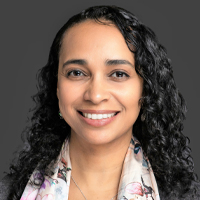
Since 2018, Gusa has been back in the lab as a postdoc at Duke University. And last summer, she was at a suburban Maryland hotel, having dinner with a group of fellow postdocs, assistant professors and more-senior science faculty from around the country. Like Gusa, most of those present were people of color, and more than half were women.
This was the first in-person retreat of the Maximizing Opportunities for Scientific and Academic Independent Careers, or MOSAIC, program, which the American Society for Biochemistry and Molecular Biology runs in collaboration with the National Institute of General Medical Sciences. Funded since 2020 by several career-development grants, MOSAIC supports researchers committed to diversity in academia as they transition from postdoctoral fellowships into faculty positions.
Over dinner, the MOSAIC scholars and the professors who volunteer for the program chatted about issues common to their experience: how to address a student’s disappointing performance, respond gracefully to casual prejudice from higher-ups, or handle the pressure and scrutiny of the academic job market.
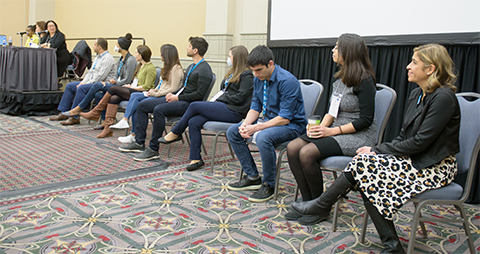
Gusa was particularly concerned about that last point. Though she had been a MOSAIC scholar for only about six months, she was aware of the grant mechanism’s tight timing requirements. It supports scientists for up to five years: two as a postdoc and three as a new faculty member. If a scholar doesn’t secure an academic position within those first two years, the second phase is forfeit.
“I was very stressed out. The K99 is a fabulous award,” Gusa said, naming the MOSAIC grant’s NIH funding mechanism. “But … you feel very constrained within that first two-year period to find a position.”
Gusa had reinvented herself professionally before, and she knew she had other options. Still, she really hoped to land a job as a professor.
A critical moment
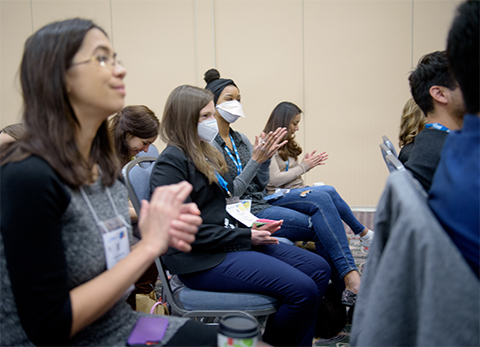
“It’s a critical moment in an academic career when you’re transitioning between postdoc and faculty,” said Christine Wood, a sociologist of science who evaluates the MOSAIC program. “Not so many of the programs to promote diversity and inclusion, or provide support to historically marginalized folks, have focused on that training stage.”
Even after decades of federal programs designed to interest students from historically excluded backgrounds in scientific careers, all aimed at diversifying academic leadership by diversifying the talent pool, racial disparity among tenured professors remains a stubborn problem.
For Kenneth Gibbs, a program officer at the NIGMS who played a key role in developing MOSAIC, the problem is as personal as it is societal. His grandfathers, raised in the Jim Crow South, had fourth- and eighth-grade educations, but both of his parents, who grew up in public housing in Connecticut, attended college with support from a federal program.
“What I say often is that my life represents the multigenerational impact of public investment,” said Gibbs, who trained as an immunologist and was a policy fellow at the American Association for the Advancement of Science before beginning his career at the National Institutes of Health. Along the way, he studied at institutions with strong track records on diversity, such as the University of Maryland, Baltimore County, and at institutions that continue to struggle with structural racism.
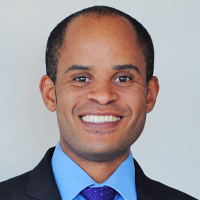
“When I was at Stanford, there were more Black presidents of the United States than there were Black tenured basic science faculty,” Gibbs said. Over time, he saw several former classmates of color, especially Black women, leave academia in response to bad experiences or lack of support.
Many Ph.D. recipients make similar decisions.
Wood said, “There’s data that show high attrition (among) people that enter the postdoc space wanting to go into an academic career … even among historically well-represented scientists.”
Statistics show that attrition is highest among what demographers call underrepresented minority groups. Black and Native postdocs, in particular, are less likely to persist as professors than their historically well-represented counterparts. With that disparity in mind, MOSAIC was designed to offer extra support.
Funding postdocs and societies
The MOSAIC program combines two NIH award mechanisms: one grant to individuals and one to scientific societies.
The NIH developed the individual mechanism, called a K99/R00, about 15 years ago to help postdocs transition to faculty positions. Unlike the original K99 (sometimes called the parent mechanism), the MOSAIC K99 requires applicants to show a track record of working to increase diversity in academia.
Informal diversity, equity and inclusion work, which can include anything from mentoring young people to advocating for new departmental policies, often is taken on by scientists who have a personal stake in changing the culture. It frequently goes unrewarded.
The institutional grant sets MOSAIC apart from other career-development awards designed to foster diversity. It goes to scientific societies to organize cohorts of MOSAIC fellows and arrange discipline-specific professional development, networking, mentoring relationships and conference travel. So far, the ASBMB, the American Society for Cell Biology and the Association of American Medical Colleges are participating.
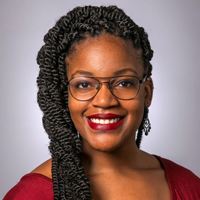
In designing the grant, Gibbs and NIGMS colleagues prioritized known barriers to career advancement — explicit and implicit bias, a sense of isolation, a lack of belonging and of networks — along with all the benefits that come with robust networking relationships, such as advice and back-channel comparison of opportunities.
“Everybody needs the same things,” Gibbs said. “Everybody needs mentoring; everybody needs networking; everybody needs skills development. … Some get those things in the research environment, but some people don’t.”
Lillian Brady, a neuroscientist at Vanderbilt University who studies sex differences in dopamine signaling in response to nicotine, was preparing a parent-mechanism K99 grant application in October 2019 when she saw an announcement about the MOSAIC award. The opportunity appealed to her right away. She delayed her application for four months to enter the first MOSAIC review, added a statement on her advocacy for diversity to her application, and learned, roughly a year after applying for the grant, that she had received it.
‘If you build it, will they come?’
Gibbs and NIGMS colleague Paula Flicker dropped into the August MOSAIC retreat for a Saturday-morning question-and-answer session on funding opportunities. After exhausting scholars’ questions, they asked for feedback about the program itself.
Gusa raised her hand.
“I probably would not have applied for a K99 if not for MOSAIC. I feel like it spoke to me, specifically,” she said. She wanted to know: Was that feeling widespread?
Absolutely, Gibbs replied. “I appreciate you saying that. That’s the intention we had when we developed the program.”
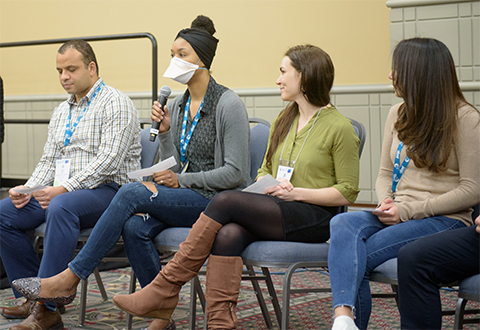
Gusa had hesitated to apply for a parent K99 because she’d heard how competitive the grant was. More than a decade after earning her Ph.D., she returned to the lab as a postdoc with Sue Jinks–Robertson at Duke, studying how mobile genetic elements in Cryptococci influence their pathogenesis. She wasn’t sure whether to try for a faculty role; she figured it depended on her ability to secure a grant.
When Jinks–Robertson forwarded her an announcement about MOSAIC, with its focus on underrepresented scholars and work similar to what she’d done as a science teacher and on a series of diversity committees, Gusa felt she would be a strong candidate. Receiving the award rekindled her dreams of becoming a professor.
MOSAIC has attracted a significantly more diverse pool of postdoc applicants than the parent K99 mechanism; about a third of K99 applicants have been female and roughly 7% from historically excluded ethnic and racial groups. As of September 2021, 76% of applicants for the MOSAIC K99 were women, and 77% were from historically excluded groups.
“The big question was, if you build it, will they come?” Gibbs said.
The answer was a resounding yes. “In the first round of MOSAIC,” Gibbs said, “we had more Black applicants than we’d had (for K99s) in the previous two or three years.”
The power of cohorts
Chelsey Spriggs was one of seven scholars in the first ASBMB MOSAIC cohort. Like Brady, when she heard about the opportunity from a friend, she already had a K99 application in the works. However, the program’s focus on service and inclusion spoke to her because she was heavily involved in science outreach efforts — and so did the cohort model. “That appealed to me so much,” she said. “I really was looking for a community of … postdocs thinking of staying in academia who were from underrepresented groups.”
It’s not that she was isolated, Spriggs said; she had plenty of professional contacts from her lab, fellow postdocs at her institution and grad school classmates. “But I was the only Black postdoc in my department,” she said. “I have networks. But they don’t look like the MOSAIC network, and they don’t experience the world similarly to me.”
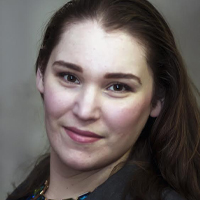
Kirsten Block directs the ASBMB’s education and professional development efforts and is principal investigator of its MOSAIC grant. “Seeing the community that the scholars have built for each other, and the bonds that they have built across departments, across disciplines, across institutions — it’s really been special,” she said.
Asynchronous, remote networking was never part of the original plan for MOSAIC. But as the first cohort of scholars came aboard in February 2021, with much of the U.S. still practicing COVID-19 control, it was clearly necessary. Cohorts begin at four-month intervals, and each cohort runs a Slack channel that includes its scholars and their coaches. These channels have become a robust community where scholars discuss everything from day-to-day life in the lab to challenging work situations.
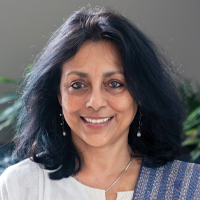
Ruma Banerjee can attest to how well-used they are. A professor at the University of Michigan Medical School, Banerjee is co-investigator of the ASBMB MOSAIC grant and a cohort coach for the first year’s scholars. She accidentally disabled notifications from her MOSAIC Slack group during the 2021 – 22 winter holidays. In February, when she visited the channel to investigate the unusual silence, she found over 2,000 unread messages.
The channels provide moral and practical support during what can be a grueling academic hiring process. Many postdocs tailor their research plans, diversity statements, teaching philosophies and cover letters to each of dozens of job openings — all while knowing that hiring committees receive hundreds of applications and that the odds of landing an interview, let alone an offer, are low. MOSAIC scholars read one another’s application materials, watch and critique research talks, and commiserate.
Every month, each cohort meets on a Zoom call with a faculty mentor. At first, these meetings focused on topics related to diversity, equity and inclusion. But many of the scholars wondered if there was a better way to use the time.
“As a Black woman in academia, I am from a historically excluded background,” Brady said. “Access to resources that support the professional development of myself and the other MOSAIC scholars will ultimately address many of the DEI-related topics that were the initial focus of the cohort meetings.”
In response to such feedback, and to the time crunch of a transitional career stage, organizers reduced the meetings’ frequency and reworked them to focus on professional development. It can be hard to select topics that appeal to a whole cohort, because — to organizers’ surprise — by the time they entered the program, many members of the first cohort had job offers already in hand. Others had not yet begun to apply.
Reasoning that a new assistant professor may be less interested in a session on chalk talks in the hiring process than someone who is preparing an application, the organizers now offer training on federal funding, microaggressions, lab management and dealing with workplace conflicts, which they hope proves useful to everyone.
‘We interact very differently in this space’
Each scholar meets monthly with their coach, an established professor at a different institution who volunteers time to give advice and guidance. The coaches, all ASBMB members, include scientists who serve on the Maximizing Access Committee, which spearheaded the society’s MOSAIC application.
The interaction between a supervising professor and a postdoc can be complex, weaving threads of collaboration, workplace hierarchy, the specter of future competition, and questions about how a trainee’s career will one day reflect on their former mentor and which research projects belong, intellectually, to whom.
“It can be really hard to disentangle and be fully behind supporting the trainee’s independent research career when your own research program is on the line,” said Alison Gammie, director of training, workforce development and diversity at the NIGMS.
The MOSAIC coaching relationship is designed to be less fraught. Coaches do not evaluate the scholars, compete with them or benefit directly from their achievements, and the two are based at different institutions.
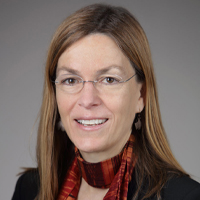
As a result of these differences, Banerjee said, the boundaries she maintains in her relationships with the postdocs in her research group are unlike those with her MOSAIC mentees. Speaking of both scholars and fellow coaches, she said, “We interact very differently in this space than any other scientific committee or community that I’ve been part of.”
That difference is palpable on both sides. For scholar Elias Picazo, an assistant professor at the University of Southern California, his relationship with his coach, fellow chemist Vahe Bandarian, is the most valuable part of the program.
“Because the dynamics of the relationship are different, I can get a different perspective when asking for advice,” Picazo said, adding that he’s more comfortable asking Bandarian certain questions than some of his other mentors.
In some cases, a MOSAIC coach is the first mentor a scholar has worked with who looks like them. Spriggs, for example, specifically requested a Black coach because she had never had a Black scientific mentor. With her coach, Duke University professor Gustavo Silva, she talks frequently about the day-to-day challenges of setting up a new lab. Because Silva started his lab just five years ago, Spriggs said, he has a fresher memory of the details than some of her other mentors.
Spriggs and Silva also discuss what’s known as the “diversity tax”: the pressure professors from historically excluded groups often feel to take up more service work related to diversity and equity than their white peers, at the expense of research time. Withdrawing from this work altogether did not feel like an option to Spriggs.
“I learned to prioritize,” she said. “I’m going to make time for the grad students, the postdocs and trainees, and then when it comes to working on other projects, or being on committees, I’ll be a little more discerning.”
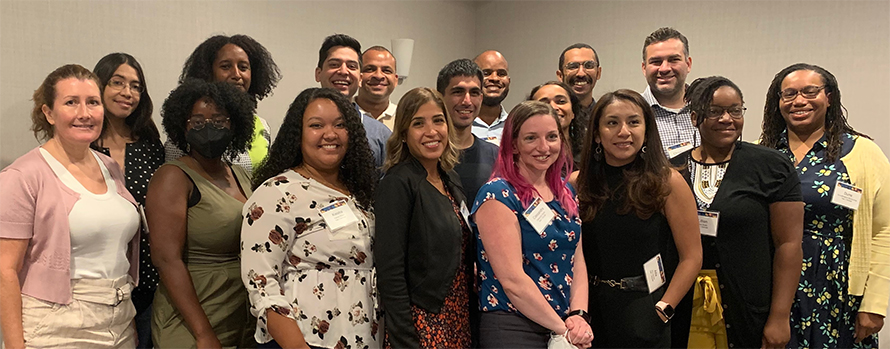
No formal coursework
According to Block and Banerjee, within some broad NIGMS guidelines, scientific societies have had a lot of flexibility to design discipline-specific training in MOSAIC programs. “The programs have unfolded in ways that … tap into the resources that are available and reflect the people that are involved,” Banerjee said.
At the ASBMB, Block said, the program offers an “a la carte menu” of professional development — such as the society’s Interactive Mentoring Activities for Grantsmanship Enhancement grant-writing workshop, known as IMAGE, and the Journal of Biological Chemistry’s early-career reviewer program — and diversity-focused programming including panel discussions on mental health and webinars on inclusive teaching. Scholars can choose to attend the offerings that work best for them.
Some of the training that organizers had hoped to offer at in-person meetings, such as an interactive workshop on laboratory management, had to be postponed or reimagined when the pandemic scrambled meeting schedules. However, most scholars said the societywide training activities aren’t really the draw; they told ASBMB Today that they’ve gotten the greatest benefit from their coaches and peers.
Joining the professoriate
During the MOSAIC retreat in August, coaches presented hypothetical case studies on transitioning from postdoc to new PI. Would you agree to this risky collaboration with a senior colleague? Should you hire a postdoc with academic ambitions soon after founding your lab when their future research program might overlap or compete with your own? How would you handle competition with a former mentor?
As a transitional grant, the K99/R00 focuses on ensuring that awardees can succeed as faculty. In addition to the professional development and coaching from the ASBMB and other societies, the award requires certain assurances from a scholar’s two home institutions, postdoctoral and professorial.
Institutional mentors must commit in writing to provide a supportive environment for a postdoc and agree in advance to the projects and research directions scholars take with them to launch their own labs.
As a recipient starts a faculty job, the grant provides for a lighter teaching load and some supplemental money for research. Before they make that transition, many scholars said, they lean on their MOSAIC coaches and fellow scholars for help with application packages, interviewing advice and employment negotiations.
With two children in high school, a husband in academia and a mother-in-law who recently moved to her area, Gusa often joked that she had more than the married academic’s well-known two-body problem — she had a five-body problem on the job market. Earlier in her postdoc, she was offered a position at Dartmouth College but had to turn it down because she couldn’t uproot her whole family from North Carolina to New Hampshire.
Gusa said that her MOSAIC coach, Sonia Flores, a University of Colorado professor and chair of the ASBMB’s Maximizing Access Committee, was perfectly suited to help her with this dilemma. Flores, too, had been through a job search constrained by dual academic careers. As Gusa began her second year on the job market, she was concerned that she might not receive a viable offer, but Flores advised her against accepting a less-than-competitive offer. “I think she felt she had shortchanged herself during the negotiation because she was so grateful for the opportunity,” Gusa said.
“I didn’t want Dr. Gusa to feel that she should settle with a subpar offer just because she wanted to stay in the Durham area,” Flores said. “I expressed to her that she should expect the same offer as anyone hired from outside the institution.”
Scholars also have in their corner the NIH program officers, including those in the NIGMS Division of Training, Workforce Development and Diversity who manage their K99/R00 grants. Program officers review offer letters to make sure they comply with the R00 program’s requirements. That can help when institutions try to recruit faculty members from historically excluded backgrounds at bargain-basement rates.
In at least one instance, Gibbs said, he and his colleagues counseled a MOSAIC scholar to decline a job offer of roughly 80% of the institution’s usual starting salary and less than half the typical startup research support. It was not just a question of equity but also of realizing the federal government’s investment in that person, Gibbs said. For someone unfamiliar with academic market rates, the package might have looked attractive, but the NIGMS staff saw at once that it was a lowball offer — and that, over time, it would likely have hindered the prospective hire’s ability to do research comparable to their colleagues.
“Our goal is to optimize the chances of (scholars) being in an environment that’s set up to be successful as they launch their independent careers,” Gibbs said.
As the first MOSAIC cohorts begin to set up their labs, they also chat frequently about negotiating with vendors. Picazo, who started his lab at USC in 2021, likened buying laboratory equipment to purchasing a car. “Vendors don’t list their prices,” he said. “If they see us with an R00, are they likely to increase the cost of something, because they know there’s liquidity?”
The Slack channel, with its lively exchange of background information on equipment pricing, lab budgets, institutional overhead and other considerations that are rarely part of postdoctoral training, is one of MOSAIC’s most helpful features, Picazo said. He and his peers ask about topics that coaches say they didn’t know about until five or 10 years into a faculty appointment. To Picazo, that’s part of the point. Some postdocs have a chance to learn these details, sometimes called academia’s hidden curriculum, early on; historically marginalized postdocs generally have not. The MOSAIC cohort alters that information imbalance.
“As soon as I learn something, I go to Slack, and I share it,” Picazo said. “As soon as someone else learns something, they go to Slack, and they share it.”
He doesn’t know whether his ethnicity affected the information he was privy to before becoming a MOSAIC scholar. But, he said, “The fact is, I didn't have that network before. And I do have it now.”
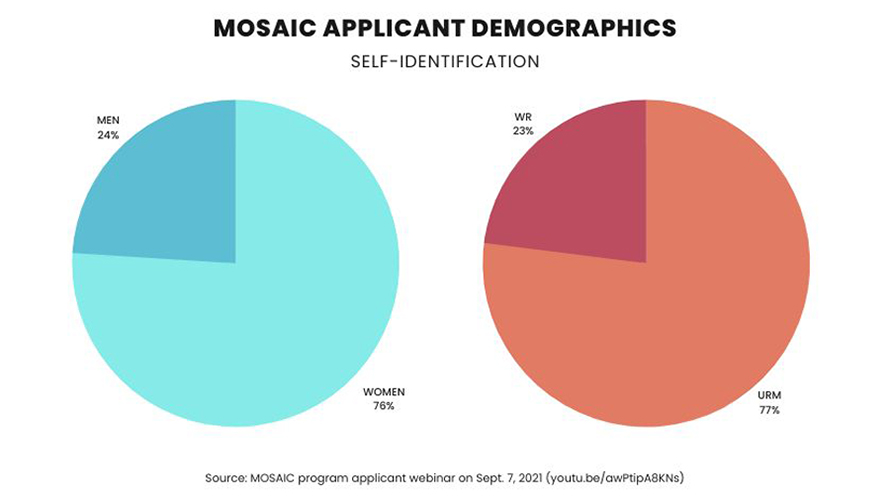
Changing the landscape
In September, Gusa accepted a tenure-track job at Duke University that will start in May. She posted right away on the cohort’s Slack channel to thank her fellow scholars and coaches for their help.
“Asiya has a really exciting project in a niche she has created,” Flores said. “She received a fantastic offer.”
Gusa regards the MOSAIC award as career-changing, even life-changing, and said she’s been spreading the word about the opportunity far and wide.
One challenge has been MOSAIC’s runaway popularity. The NIGMS had forecast about 30 scholars by year 2, Gibbs said; instead, they’ve made 81 awards. The program has been adopted across the NIH; 22 of the NIH’s 27 institutes and centers have joined, making the grant available to researchers from a wider range of scientific disciplines.
All 22 granting NIH organizations now are funneling scholars into the three approved societies, putting a strain on staff and volunteers. Two years in, the ASBMB is hosting 27 scholars — more than organizers expected to have in total after the program reaches steady state in five years. Block, Banerjee and the rest of the ASBMB MOSAIC team have scrambled to make sure each scholar can be matched to a mentor and to keep logistical operations running smoothly for nearly three times the expected number of participants.
NIGMS staff, meanwhile, are encouraging other scientific societies to apply to expand the program’s capacity. “Leadership across all of NIGMS and all of NIH is very committed to this program,” Gammie said.
Although these are early days, everyone involved seems to agree the program is a success. “Surprisingly, we are accomplishing some of our medium-term goals, even though we’re in the short term — and that’s because we have such a talented cohort of scholars,” Banerjee said.
“When you make a fellowship seem more accessible to people who don’t ordinarily see themselves as being successful K award winners,” Gusa said, “it really changes the landscape of possibilities for your career.”
How to apply for a MOSAIC K99
While the MOSAIC program started at the National Institute for General Medical Sciences, 22 of the 27 NIH institutes and centers now participate in the mechanism, expanding its reach to many disciplines in the life and medical sciences.
Any postdoc can apply; the award is not limited by race or ethnicity. However, applicants must show a compelling commitment to increasing diversity and equity in the scientific workforce. An application must include both a strong research proposal and a statement illustrating commitment to diversity.
According to Kenneth Gibbs and Alison Gammie at the NIGMS, all the usual suggestions for preparing a strong grant application apply to the MOSAIC award; an applicant should reach out to a program officer before submitting an application, start early and make sure to have the application reviewed by a team of colleagues before submitting it.
Postdocs who would like to learn more can visit the NIH website and watch a recording of a September webinar for prospective applicants on the NIGMS YouTube channel.
Enjoy reading ASBMB Today?
Become a member to receive the print edition four times a year and the digital edition monthly.
Learn moreFeatured jobs
from the ASBMB career center
Get the latest from ASBMB Today
Enter your email address, and we’ll send you a weekly email with recent articles, interviews and more.
Latest in Careers
Careers highlights or most popular articles

Mapping proteins, one side chain at a time
Roland Dunbrack Jr. will receive the ASBMB DeLano Award for Computational Biosciences at the ASBMB Annual Meeting, March 7–10, just outside of Washington, D.C.

Exploring the link between lipids and longevity
Meng Wang will present her work on metabolism and aging at the ASBMB Annual Meeting, March 7-10, just outside of Washington, D.C.

Upcoming opportunities
Calling all biochemistry and molecular biology educators! Share your teaching experiences and insights in ASBMB Today’s essay series. Submit your essay or pitch by Jan. 15, 2026.

Defining a ‘crucial gatekeeper’ of lipid metabolism
George Carman receives the Herbert Tabor Research Award at the ASBMB Annual Meeting, March 7–10, just outside of Washington, D.C.

Building the blueprint to block HIV
Wesley Sundquist will present his work on the HIV capsid and revolutionary drug, Lenacapavir, at the ASBMB Annual Meeting, March 7–10, in Maryland.

Upcoming opportunities
Present your research alongside other outstanding scientists. The #ASBMB26 late-breaking abstract deadline is Jan. 15.

